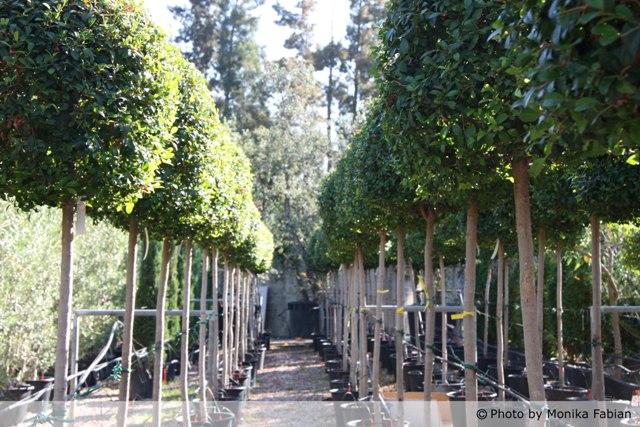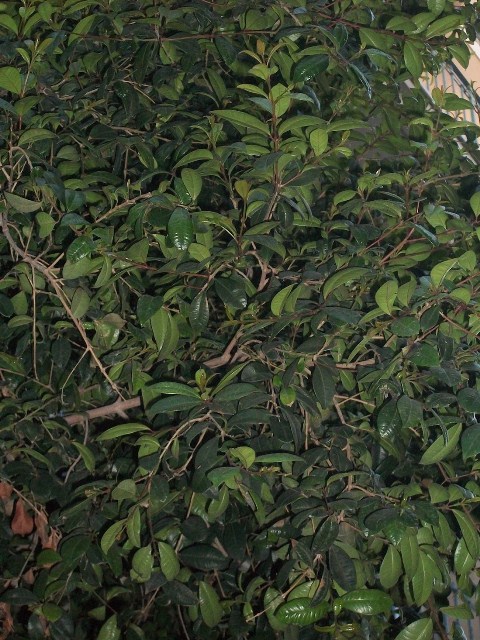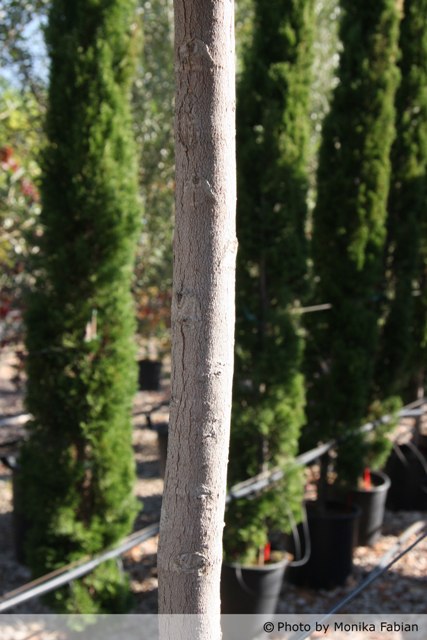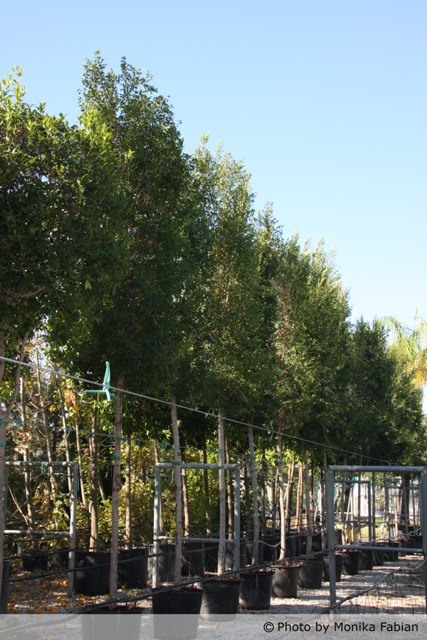Eugenia myrthifolia (brush berry)
Eugenia is a large group of plants, including evergreen trees and shrubs. The evergreen leaves are glossy small 2-3 cm. The flowers are white without any fragrance. One of the Eugenia species ( Eugenia aromatica )gives the famous fragrant "herb" the cloves by its dried flower buds .The flowers are followed by the production of berries, some types of which are edible. The smooth, brown to grey, mottled bark and tight canopy of fine-textured leaves makes Eugenia well suited for many landscape situation. Multiple trunked trees or shrubs are often specified for specimen planting so the beautiful bark can be displayed. Trees can be trained in the nursery to one central trunk therefore could be used as a streets plantation , in highway medians, parking lots plant special because they adopt well to small space. Eugenia should be grown in full sun or part shade on well-drained soil. Once established in the landscape, they are drought tolerant requiring little, if any, irrigation.
- Landscape Information
- Botanical Description
- Horticulture Management
-
-
By JMK (Own work) [GFDL (http://www.gnu.org/copyleft/fdl.html) or CC BY-SA 3.0 (http://creativecommons.org/licenses/by-sa/3.0)], via Wikimedia Commons
-
By John Tann from Sydney, Australia (Magenta lillypilly) [CC BY 2.0 (http://creativecommons.org/licenses/by/2.0)], via Wikimedia Commons
-
-
-
Search plant on Google
Download as PDF
-
Pronunciation: sizz-ZYE-gee-um pan-nick-yoo-LAY-tum
-
Plant type: Tree
-
Origin: North America
-
Heat Zones: 1 to 12
Hardiness Zones: 10 to 12
-
Uses: Screen, Specimen, Container, Shade, Wildlife, Street, Pollution Tolerant / Urban, Reclamation
-
Size/Shape
Growth Rate: Moderate
Tree Shape: Vase
Canopy Symmetry: Symmetrical
Canopy Density: Dense
Canopy Texture: Fine
Height at Maturity: 5 to 8 m
Spread at Maturity: 5 to 8 meters
-
-
By JMK (Own work) [GFDL (http://www.gnu.org/copyleft/fdl.html) or CC BY-SA 3.0 (http://creativecommons.org/licenses/by-sa/3.0)], via Wikimedia Commons
-
By John Tann from Sydney, Australia (Magenta lillypilly) [CC BY 2.0 (http://creativecommons.org/licenses/by/2.0)], via Wikimedia Commons
-
-
-
Search plant on Google
Download as PDF
-
Foliage
Leaf Arrangement : Opposite
Leaf Venation: Pinnate
Leaf Persistance: Evergreen
Leaf Type: Simple
Leaf Blade: Less than 5
Leaf Shape: Oval
Leaf Margins: Entire
Leaf Texture: Smooth
Leaf Scent: No Fragance
Color(growing season): Green
Color(changing season): Green
-
Flower
Flower Size Range: 1.5 - 3
Flower Type: Umbel
Flower Sexuality: Monoecious (Bisexual)
Flower Scent: No Fragance
Flower Color: White
Seasons: Spring, Summer
-
Trunk
Trunk Susceptibility to Breakage: Generally resists breakage
Number of Trunks: Multi-Trunked, Can be trained to one trunk
Trunk esthetic Values: Showy
-
Fruit
Fruit Type: Berry
Fruit Showiness: Yes
Fruit Size Range: 0 - 1.5
Fruit Color: Red
Seasons: Spring, Summer
-
-
By JMK (Own work) [GFDL (http://www.gnu.org/copyleft/fdl.html) or CC BY-SA 3.0 (http://creativecommons.org/licenses/by-sa/3.0)], via Wikimedia Commons
-
By John Tann from Sydney, Australia (Magenta lillypilly) [CC BY 2.0 (http://creativecommons.org/licenses/by/2.0)], via Wikimedia Commons
-
-
-
Search plant on Google
Download as PDF
-
Tolerance
Salt Tolerance: Moderate
-
Requirements
Soil Requirements: Clay, Loam, Sand
Soil Ph Requirements: Acidic, Neutral, Alkaline
Water Requirements: Moderate
Light Requirements: Full, Part
-
Management
Susceptibility to Pests and Diseases: No
Pruning Requirements: Little needed, to develop a strong structure
Fruit/ Leaves/ Flowers litter: No
Life Span: 25-50 years
Edible Parts: Fruit
Plant Propagation: Seed, Cutting




